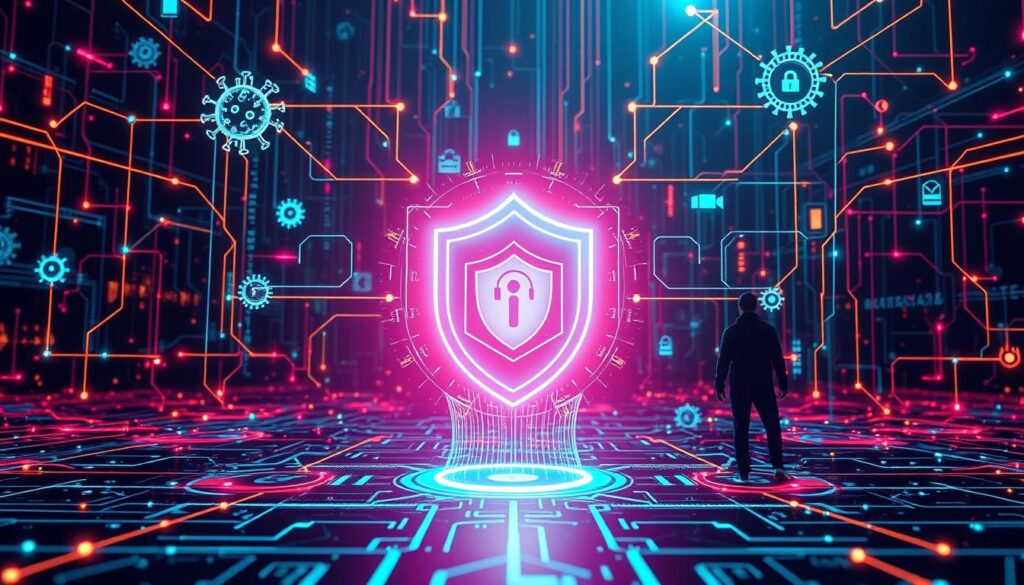
Over 90% of successful cyberattacks happen because of human mistakes, says the Cybersecurity and Infrastructure Security Agency (CISA). This shows how important it is for companies to have strong cybersecurity governance. Good cybersecurity governance is like a map for keeping your digital assets safe.
It includes clear information security policies, who is accountable, and how decisions are made. This helps fight off the growing number of cyber threats. With more focus on cybersecurity and strict rules, it’s more important than ever to follow the best practices.
Understanding Cybersecurity Governance
Cybersecurity governance is key to managing cyber risks in organizations. It ensures compliance with laws and aligns cybersecurity strategies with business goals. With 92% of businesses hit by cyberattacks in 2018, its importance is clear.
Assigning accountability to cybersecurity is vital. When management leads in cybersecurity, it boosts security awareness. Research shows 72% of businesses feel more secure with proactive management.
Integrating cybersecurity into governance is a big challenge for 60% of businesses in 2020. A lack of cybersecurity experts also hinders effective governance. CISOs are critical in setting up good cyber risk management, using financial metrics to communicate risks.
Good governance includes strong cybersecurity policies and oversight. Organizations must create frameworks that manage risks and promote security at all levels.
Importance of Cybersecurity Governance
Understanding the importance of cybersecurity governance is key for any organization. It helps protect assets and operations. Effective governance frameworks show readiness against cyber threats, boosting investor confidence.
Research shows strong cybersecurity measures can cut data breach risks by about 40%. This shows governance’s vital role in keeping information safe and investor trust.
Regulatory compliance is a core part of cybersecurity governance. Companies that follow compliance can save up to 25% on legal costs. They face strict checks from regulatory bodies, making compliance essential.
By setting up strong governance, businesses can meet these demands. This helps avoid penalties that could harm their finances.
Cybersecurity governance also helps manage cyber risks. A big 60% of small and mid-sized businesses fail after cyberattacks. This shows the need for solid incident response plans.
Companies with good risk management see a 27% lower chance of big cyber incidents. Regular risk assessments help prevent unauthorized access, boosting cyber resilience.
Employee training and awareness are also key. Over 90% of data breaches come from human error. Training can cut phishing attack success by 45%.
By focusing on cybersecurity governance, companies can build a secure culture. This is vital for protecting digital assets in today’s cyber threats.
Key Elements of an Effective Cybersecurity Governance Framework
An effective cybersecurity governance framework has key elements. These ensure organizations manage cyber risks well and meet business goals. For 75% of companies, aligning cybersecurity with business goals is a top priority. This helps in stability and growth.
Comprehensive information security policies are vital. They guide cybersecurity management, helping companies tackle compliance and risk. Senior leadership’s involvement in governance boosts compliance by 60%. This shows the need for strong accountability, found in nearly 90% of effective frameworks.
It’s important to monitor and manage cybersecurity risks constantly. Using frameworks like NIST SP 800-171 or ISO 27001 can cut compliance violations by 50%. Standardized workflows help in monitoring and reduce errors, benefiting 70% of businesses.
The financial side of cyber governance is significant. Identifying inefficiencies can save 30% in resources. Adopting continuous monitoring can speed up incident response by up to 40%, showing the value of proactive steps.
Here are the main parts of a good cybersecurity governance framework:
| Element | Description | Impact |
|---|---|---|
| Strategic Alignment | Align cybersecurity objectives with business strategies. | 75% prioritize alignment for stability and growth. |
| Accountability Structures | Define roles and responsibilities within the organization. | 90% have clear structures for organizational responsibility. |
| Continuous Monitoring | Implement regular checks for vulnerabilities and threats. | Improves incident response times by 40%. |
| Standardized Policies | Create detailed information security policies. | Helps with compliance and lowers violations. |
| Training and Awareness | Do regular security awareness training for staff. | Reduces employee phishing susceptibility from 60% to 10%. |
Cybersecurity Governance Best Practices
Protecting sensitive data is key for organizations. A clear governance structure is vital. It helps everyone know their roles and duties. Strong information security policies guide data protection, and accountability frameworks track how well these policies are followed.
Establish a Clear Governance Structure
A solid governance structure is the base of good cybersecurity management. It makes roles and duties clear. This leads to better decision-making and teamwork.
- Clear reporting lines and management hierarchy
- Regular reviews of access privileges at least every three months
- Involvement of executive leadership in cybersecurity oversight
Develop Comprehensive Information Security Policies
Information security policies are key for guiding data handling. They cover important areas like:
- Access control measures based on the need-to-access principle
- Guidelines for creating unique, complex passwords to strengthen security
- Protocols for monitoring authorized user activities to prevent unauthorized access
Implement Accountability Frameworks
An accountability framework ensures everyone follows security rules. It includes:
- Regular cybersecurity awareness training for all personnel
- Annual third-party audits of security controls
- Documenting and evaluating the confidentiality, integrity, and availability of information systems during risk assessments
By using these strategies, you boost your security and keep your organization strong against threats.
Aligning Cybersecurity Strategies with Business Objectives
Aligning cybersecurity strategies with business goals is key for companies to protect their operations and grow. A solid cybersecurity strategy helps integrate security measures that support the company’s vision. Working with stakeholders from different areas ensures security plans match the organization’s success criteria.
Understanding the changing threat landscape is essential. With more cyber threats, companies must actively manage risks. Using frameworks like the NIST Cybersecurity Framework helps identify, protect, detect, respond to, and recover from threats. This method ensures cybersecurity strategies align with business goals and meet regulatory standards.
Here are the benefits of aligning cybersecurity with your business objectives:
- Enhanced Resource Allocation: Proper alignment improves resource allocation by focusing on high-risk areas.
- Security as a Business Enabler: Seeing security as an enabler can make processes smoother, increase efficiency, and boost productivity.
- Improved Customer Trust: Strong security builds brand loyalty, essential for keeping customer trust in the digital world.
- Performance Benchmarking: Regular assessments against industry standards help find areas for improvement, raising the security level.
- Clear Benchmark Establishment: Setting clear targets based on regulations guides ongoing improvement efforts.
It’s important for security and business leaders to keep in touch and work together. This partnership strengthens the cybersecurity framework, aligning it with the company’s growth goals.
Small and medium-sized businesses greatly benefit from having a dedicated security leader or a Fractional Chief Information Security Officer (CISO). This approach reduces costs from breaches and ensures cybersecurity plans align with business goals.
| Benefits of Cybersecurity Alignment | Description |
|---|---|
| Enhanced Resource Allocation | Prioritizes investments in high-risk areas, optimizing resource efficiency. |
| Security as a Business Enabler | Streamlines processes, driving efficiency and improving productivity. |
| Improved Customer Trust | Protects brand reputation, critical for maintaining customer loyalty. |
| Performance Benchmarking | Identifies areas for improvement, strengthening the overall security posture. |
| Clear Benchmark Establishment | Guides continuous improvement efforts through clear internal targets. |
Risk Management in Cybersecurity Governance
Effective risk management in cybersecurity is key to protecting sensitive information. Organizations must start with a detailed cyber risk assessment. This step helps identify and evaluate risks.
This approach is the first step in creating plans to counter vulnerabilities. It’s a proactive way to safeguard against threats.
Identifying and Assessing Cyber Risks
Understanding cyber risks involves knowing threats, vulnerabilities, and their consequences. Threats like malware and phishing attacks pose big challenges. Vulnerabilities are weaknesses in systems or controls that can be exploited.
Getting C-level executives involved in risk assessments boosts success rates by 38%. This shows how important their role is in managing risks.
Creating Mitigation Plans for Risks
After identifying risks, creating mitigation plans is essential. These plans should focus on the most critical risks and allocate resources effectively. Using data and best practices makes these plans more effective.
Organizations that keep a close eye on their risk management can cut financial losses by 50%. Regularly checking and improving risk management can boost cybersecurity by 40% in a year.

| Key Components of Cyber Risk Management | Description |
|---|---|
| Risk Identification | Recognizing threats and vulnerabilities that could affect the organization. |
| Risk Assessment | Evaluating the impact of risks on operations and assets. |
| Mitigation Plans | Creating plans to address and reduce identified risks. |
| Continuous Monitoring | Regularly reviewing and updating risk management strategies to adapt to new threats. |
Cybersecurity Compliance and Regulatory Considerations
It’s key to know the laws and standards for cybersecurity compliance. Rules like GDPR, HIPAA, and CCPA require strict data protection. Not following these can lead to big fines and harm to your reputation. Knowing these rules helps your organization handle cybersecurity well.
Understanding Applicable Laws and Standards
Many regulations guide cybersecurity efforts:
- GDPR: Failing to comply can cost up to €20 million or 4% of your annual revenue.
- HIPAA: Healthcare must use strong encryption and access controls for patient data.
- GLBA and SOX: Financial groups must protect consumer data with specific cybersecurity steps.
- PCI-DSS: Businesses handling credit card info must use strong encryption and scan for vulnerabilities.
- NERC-CIP: Critical sectors must follow standards to reduce cyber risks.
- SEC Regulations: Public companies must report cybersecurity risks in their annual reports.
Regular Compliance Monitoring and Reporting
Regular audits and assessments are vital for compliance. This helps spot vulnerabilities early. A structured monitoring program offers many benefits:
- It avoids big fines for non-compliance.
- It improves security by checking current policies.
- It can lower insurance costs by showing good cybersecurity practices.
- It boosts success by understanding and following rules.
Tools like gap analysis help find and fix compliance gaps. Keeping your cybersecurity policies up-to-date is also key. With the right plan, your organization can meet rules and strengthen its security.
| Regulation | Industry | Key Requirements | Potential Penalties |
|---|---|---|---|
| GDPR | All Industries | Data protection measures, consent requirements | Up to €20 million or 4% of global revenue |
| HIPAA | Healthcare | Encryption, access controls | Variable fines, reputational damage |
| GLBA & SOX | Financial Services | Consumer data protection measures | Fines, legal actions |
| PCI-DSS | Retail | Strong encryption, vulnerability scanning | Fines, increased transaction fees |
Implementing a Cybersecurity Framework
For organizations, adopting a cybersecurity framework is key to protecting assets. Using frameworks like the NIST Cybersecurity Framework or CIS Controls helps manage risks. These frameworks give clear guidelines and steps to boost cyber resilience.
Utilizing NIST Cybersecurity Framework
The NIST Cybersecurity Framework has a tiered approach to improve security:
- Partial: Businesses lack security measures and have limited knowledge of cybersecurity risks.
- Risk-informed: Companies acknowledge cybersecurity threats but do not have strategic plans in place.
- Repeatable: Organizations consistently follow best practices with effective risk management tactics.
- Adaptive: Cyber-resilient companies utilize predictive indicators to foresee and mitigate possible attacks.
Using the NIST Cybersecurity Framework helps everyone in the organization understand risk levels. It also helps with budgeting based on risk assessments.
Exploring CIS Critical Security Controls
The CIS Controls framework has 18 security controls to help organizations improve their cybersecurity. By following these controls, you can take practical steps to defend against common threats. You can also compare your security practices to these controls to find areas for improvement.
By combining the NIST Cybersecurity Framework and CIS Controls, you make big steps towards better security. Regular audits and assessments are key to finding and fixing gaps. This leads to better protection of sensitive data and following regulations.
Developing Cybersecurity Incident Response Plans
Creating effective cybersecurity incident response plans is key for organizations. These plans outline actions to take during a breach. They help reduce damage and get operations back on track. A good plan needs a solid communication strategy to keep everyone informed and know their roles.

Establishing a Communication Strategy
A strong communication strategy is essential for incident response success. Without it, wrong information can spread, making things worse. Here are ways to improve your communication strategy:
- Clear Roles: Make sure everyone knows their part in an incident.
- Regular Updates: Keep everyone informed at each step to build trust.
- Post-Incident Review: Review after an incident to make future plans better.
Training and Awareness Programs for Staff
Human mistakes cause about 85% of cyber breaches. It’s vital to train your employees well. Training helps them spot threats and act right during an incident. Here are some training tips:
- Regular Drills: Practice with simulated incidents to test your plan.
- Tailored Content: Use specific training for your organization’s risks.
- Continuous Education: Keep staff up-to-date with new threats and trends.
A solid incident response plan, good communication, and thorough training boost your organization’s cyber defense. These steps prepare your team to handle incidents well. This way, you reduce downtime and keep operations running smoothly.
Strengthening Data Protection Measures
Keeping sensitive information safe is key to earning customer trust. The cost to fix a data breach has jumped to USD 4.45 million in 2023. This shows how vital strong data security plans are.
Companies should use strong encryption, strict access rules, and regular checks. Sorting data by how sensitive it is helps protect the most important stuff. This way, you meet rules and keep data safe based on its value.
Good access control means giving users only what they need. This includes:
- Full Control
- Modify
- Read and Execute
- Read
- Write
Using data discovery tools also helps control access to sensitive data. This lowers the chance of data leaks and loss. Keeping data organized and labeled right is key to avoiding these risks.
Always be updating your data protection plans to stay ahead of cyber threats. Companies that do well in handling breaches spend USD 1.49 million less. They also fix problems 54 days quicker. Yet, 77% of companies feel they’re not ready for cyberattacks. This shows we need to do more to keep data safe.
| Data Classification | Description |
|---|---|
| Public data | Requires no special protection. |
| Private data | Accessible by employees but protected from public view. |
| Confidential data | Shared with selected users, including proprietary information. |
| Restricted data | Highly sensitive information protected by regulations, such as medical records and financial data. |
Improving data protection is more than just a task. It’s the foundation of solid data security. It’s what keeps sensitive information safe in today’s complex online world.
Continuous Improvement and Adaptation of Security Policies
The world of cybersecurity is always changing. This means we need to keep improving our security plans. With cyber-attacks going up by 15% every year, it’s key to stay ahead. We must update our policies often to fight these growing threats.
Training employees is a big part of this. A huge 70% of businesses say they’re weak because their staff isn’t well-trained. Teaching staff about common mistakes can make our cybersecurity policies much stronger.
Don’t forget about regular risk checks. Even though 63% of companies don’t have a clear plan, checking risks often can help. Firms that check themselves often can spot problems before they cause big trouble.
Learning from past attacks is also very important. By using what we learn from past attacks, we can make our plans better. Companies that act fast can reduce the damage from attacks, which can cost a lot, about $4.35 million on average.
In short, the fast-changing world of cybersecurity needs us to keep improving. By making our plans better, training well, and checking risks often, we can protect ourselves from many dangers.
Conclusion
As cybersecurity evolves, it’s key for your organization to protect its digital assets. This is vital to meet regulatory demands. The average cost of a ransomware breach was $4.54 million in 2022. This shows the importance of taking the right steps to avoid big financial losses.
Creating a clear governance structure helps align cybersecurity with business goals. This not only reduces risks but also boosts stakeholder trust. It’s important to keep improving security policies and check for compliance regularly. This way, you can stay ahead of new threats.
In the end, as cyber threats grow more complex, it’s essential to focus on risk management and training. Organizations that focus on these areas will be better protected online. They will also gain the trust of their customers and partners.
Source Links
- Cybersecurity Governance | CISA
- Navigating Cybersecurity Governance: How to Build an Effective Strategy | Secureframe
- Best Practices for Cybersecurity in Federal Agencies
- Cybersecurity Governance: Best Practices for European Companies
- Cybersecurity Governance: A Short Guide | SafetyCulture
- Council Post: The Art Of Cybersecurity Governance: Safeguarding Beyond Code
- Cybersecurity governance: A path to cyber maturity | TechTarget
- What is Cybersecurity Governance? | Vanta
- What Is Cybersecurity Governance? Quick Guide – Sprinto
- Your Guide to Implementing Effective Cyber Governance
- Cybersecurity Program Best Practices
- What is Cyber Security? Definition & Best Practices
- How to Align Your Cybersecurity Strategy with the NIST Framework
- Aligning Security Strategies with Business Objectives: A Guide for Effective Cybersecurity
- Aligning Cyber Risks with Business Objectives: The Essential Role of Security Leadership in SMBs
- What is Cyber Risk Governance? Implementing Cyber Strategy | UpGuard
- Cybersecurity Risk Management: Frameworks, Plans, and Best Practices
- The Strategic Benefits of Cybersecurity Compliance
- What Is Cybersecurity Compliance? Regulations by Industry
- What Is Cybersecurity Compliance | CompTIA
- Cyber Security Framework: Definition and Best Practices
- Cybersecurity Governance Toolkit
- How to Implement the NIST Cybersecurity Framework (CSF) to Foster a Culture of Cybersecurity
- How to develop an effective cyber incident response plan
- Cybersecurity Incident Response Plans: Best Practices | Register.bank
- How to Create a Cybersecurity Incident Response Plan
- How to Build a Successful Data Protection Strategy | IBM
- Data Security Best Practices to Protect Your Business
- Cybersecurity Governance: The Key to Sustained Digital Resilience
- How To Plan & Develop An Effective Cybersecurity Strategy
- Building Effective Cybersecurity Governance
- 12 Cybersecurity Best Practices to Prevent Cyber Attacks in 2024 | Syteca
- What Is Cybersecurity Governance and Why Does It Matter?



